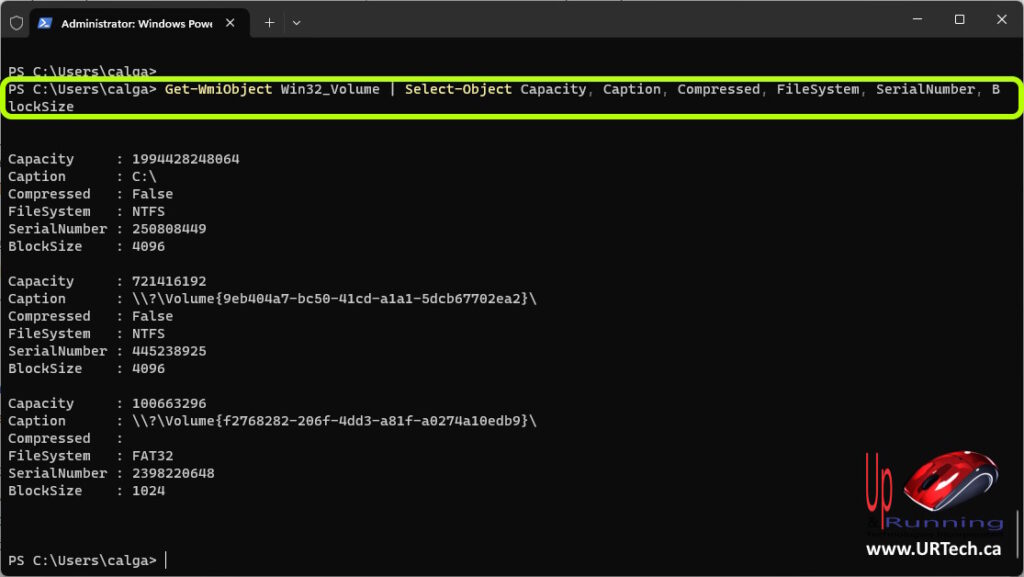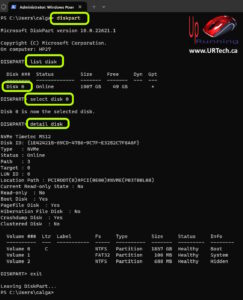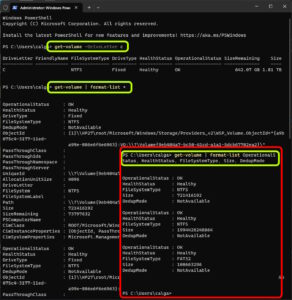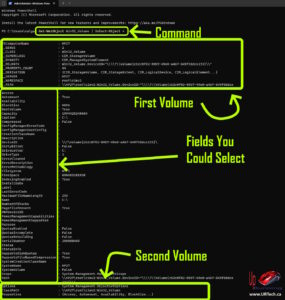Recently we were working with a client that had an obscure disk volume problem and we needed to find an even more obscure reference to that disk. In this article we will show you three different ways to list the details of a disk and its volume. This includes the disk GUID, Volume Names, Device ID and more.
Simply as a point of clarity for newbies we should explain the difference between a disk and a volume. A disk is the physical storage drive, and it can be segmented into multiple volumes. So, 1 disk might have 3 or 4 or 5 (or more volumes) which you may see as C:\ E:\ L:\ M:\ (or any other drive letters) in your Windows File Manager and Disk Management.
1 – Simple Command To List Most Disk and Volume Information
- Launch a CMD Prompt, PowerShell, or (as shown in the screenshot below) a Windows Terminal AS AN ADMINISTRATOR
- Type DISKPART and press ENTER
- Type LIST DISK and press ENTER
- Find the disk number you have a question about in the list and type SELECT DISK # and press ENTER
- Type DETAIL DISK and press ENTER
If the screenshot you can see these commands show you nearly all of disk and volume details most techs care about. For instance which disk is referred to in The device, \Device\Harddisk0\DR7, is not ready for access yet. You can see in the screenshot that HARDDISK0 is the the only disk on this particular computer.
However you may need more information. For instance, DISK PART does not show you the GUID of disk.
There several commands to display even more information about your disks and volumes but each uses a slightly different syntax to show you much of the same information with slightly different field names. If you are trying to find details on a particular field name from an error message or alert, these two different methods will likely save you.
2 – Simple PowerShell Command To List ALL Disk & Volume Information
- Launch a PowerShell or (as shown in the screenshot below) a Windows Terminal AS AN ADMINISTRATOR
- Type
Get-Wmiget-volume -DriveLetter cand press ENTER
.
and if you want all the disk and volume information: - Type
get-volume | format-list *and press ENTER
.
and if you want only some of the volume information, just specify the fields you are interested in: - Type
get-volume | format-list OperationalStatus, HealthStatus, FileSystemType, Size, DedupModeLetterand press ENTER
3 – Simple Command To List ALL Disk and Volume Information
- Launch a PowerShell or (as shown in the screenshot below) a Windows Terminal AS AN ADMINISTRATOR
- Type
Get-WmiObject Win32_Volume | Select-Object *and press ENTER
This simple command will provide you with all the detail that Windows Management Instrumentation aka WMI has about a particular disk including all of its volumes, the guid that Windows assigns to each disk volume, the file system type, the disk serial number, the block size, capacity, whether it’s compressed or not.
If that is too much information, you can slightly modify the command to show only the fields you need, by looking and the names of fields in the screenshot example above. Perhaps you only want to know:
- the friendly name (aka Caption)
- whether or not the disk is compressed
- the file system type (i.e. NTFS, FAT32…)
- the disk volume serial number
- the block size
- Launch a PowerShell, or (as shown in the screenshot below) a Windows Terminal AS AN ADMINISTRATOR
- Type
Get-WmiObject Win32_Volume | Select-Object Capacity, Caption, Compressed, FileSystem, SerialNumber, BlockSizeand press ENTER

Here is the full output so you can copy/paste the field names
Windows PowerShell
Copyright (C) Microsoft Corporation. All rights reserved.
Install the latest PowerShell for new features and improvements! https://aka.ms/PSWindows
PS C:\Users\calga> Get-WmiObject Win32_Volume | Select-Object *PSComputerName : HP27
__GENUS : 2
__CLASS : Win32_Volume
__SUPERCLASS : CIM_StorageVolume
__DYNASTY : CIM_ManagedSystemElement
__RELPATH : Win32_Volume.DeviceID="\\?\Volume{cb2c0f02-09b7-49e0-a46f-649f58dce233}\"
__PROPERTY_COUNT : 44
__DERIVATION : {CIM_StorageVolume, CIM_StorageExtent, CIM_LogicalDevice, CIM_LogicalElement…}
__SERVER : HP27
__NAMESPACE : root\cimv2
__PATH : \HP27\root\cimv2:Win32_Volume.DeviceID="\\?\Volume{cb2c0f02-09b7-49e0-a46f-649f58dce
233}\"
Access :
Automount : True
Availability :
BlockSize : 4096
BootVolume : True
Capacity : 1994428248064
Caption : C:\
Compressed : False
ConfigManagerErrorCode :
ConfigManagerUserConfig :
CreationClassName :
Description :
DeviceID : \?\Volume{cb2c0f02-09b7-49e0-a46f-649f58dce233}\
DirtyBitSet : False
DriveLetter : C:
DriveType : 3
ErrorCleared :
ErrorDescription :
ErrorMethodology :
FileSystem : NTFS
FreeSpace : 690483281920
IndexingEnabled : True
InstallDate :
Label :
LastErrorCode :
MaximumFileNameLength : 255
Name : C:\
NumberOfBlocks :
PageFilePresent : True
PNPDeviceID :
PowerManagementCapabilities :
PowerManagementSupported :
Purpose :
QuotasEnabled : False
QuotasIncomplete : False
QuotasRebuilding : False
SerialNumber : 250808449
Status :
StatusInfo :
SupportsDiskQuotas : True
SupportsFileBasedCompression : True
SystemCreationClassName :
SystemName : HP27
SystemVolume : False
Scope : System.Management.ManagementScope
Path : \HP27\root\cimv2:Win32_Volume.DeviceID="\\?\Volume{cb2c0f02-09b7-49e0-a46f-649f58dce233}\"
Options : System.Management.ObjectGetOptions
ClassPath : \HP27\root\cimv2:Win32_Volume
Properties : {Access, Automount, Availability, BlockSize…}
SystemProperties : {__GENUS, __CLASS, __SUPERCLASS, __DYNASTY…}
Qualifiers : {dynamic, locale, provider}
Site :
Container :






0 Comments